Cigarettes: 0 Meat Pies:2
Units of Alcohol: Several Calories: Infinite
We weren’t looking forward to the drive down to Dunedin (Gaelic for Edinburgh) as it was destined to last for 6½ hours and was mainly through the Canterbury plains, which were flat and full of sheep. However, there were a few gems along the way which made it go by a lot faster than we expected. The first stop was Oamuru, where the houses were made out of the local limestone, unusual for NZ where the majority of houses are made of wood and clad with wooden weatherboard. Timaru was our next stop – a real gem architecturally as there were several grand buildings built in mock Venetian style, with impressive columns in the front. It was also the place for our virginal experience – the ubiquitous meat pie. We chanced upon an artisan bakery (possibly German in origin!) but they made the most fantastic meat pies – we had steak and cheese and there surely can’t be a pie to equal them. The pastry was exquisite and the meat inside was so tender and plentiful.
Moving on south we stopped off to view the Moeraki boulders, which are naturally created concrete boulders which have been washed away from the sea cliffs and now lay along the shore.
Dunedin was a great city and the place of the first NZ university, established by its early Scottish settlers. As we checked into our motel we were informed that we had arrived at the end of ‘orientation’ week – aka freshers’ week. Most of the students we encountered and heard over the next two nights seemed more disorientated than orientated! There are several imposing buildings in Dunedin, especially the railway station, which apparently has been listed as one of the top 100 buildings in the world. We also discovered Speights Distinction ale, which is now our favourite early evening drink.
Just outside Dunedin is the Otago peninsular, a wildlife haven of sea lions, albatross, penguins and great walks and views. We managed to see a sea lion basking on the sand, but not the others.
After Dunedin, we headed on to Invercargill, intending to visit the bays along the way, known as the Catlins and famous for scenery and wildlife. We couldn’t understand why we saw several cars just parked along the coast with their passengers just staring out to sea. However, as we drove along we were stopped by an environmental protection officer who told us not to go down to the beach as there was a tsunami warning because of the Chile earthquake. Chile is about 8500 kilometres away across the Pacific Ocean, but there is nothing in between. The only advice he could offer us was ‘if you see the sea recede, head for high ground!’. So our route was a bit restricted because of the bays being blocked off. By the time we got to Invercargill the temperature had dropped about 10 degrees and it had started to rain. Invercargill looked a bit depressing, it was Sunday evening and we had to put the heating on and get our jeans and trainers out.
It rained all night and we set off in our warm clothes on the next leg to Te Anau, the heart of NZ’s fiordland on the west coast, famous for its spectacular scenery from organized cruises along the ‘sounds’. It was lunchtime when we arrived, and so, dear readers, we sinned again and headed for the nearest pie shop to try yet another variety – venison for Dan and steak and mushroom for me. We shall both be the size of a house when we get back to England, we’re already the size of a bungalow! In the afternoon we went to the small cinema in town to see a locally produced film of the region shot by a helicopter pilot who realized he had such an exclusive view of the landscape that he wanted to share it. He even built the cinema to show it in, and it was a beautiful film of lakes, waterfalls, wildlife and mountains.
The day of our trip to Doubtful Sound arrived grey, cold and wet and thus it remained for the entire day. We travelled first by boat, then coach for a look around an underground hydropower station which powers an aluminium smelting plant in Invercargill 150 miles away. Then it was back onto a boat for a 3 hour cruise through the fiordland. Apparently we were lucky it was raining as the waterfalls were spectacular and they are produced exclusively by rainfall, unfortunately the penguins and seals decided to stay indoors. Still never mind, we’re already talking about the next time we come and what we will visit or revisit.

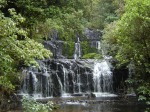

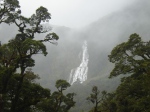
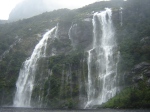
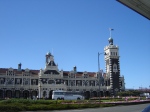
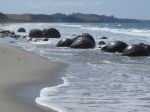
2 comments
Comments feed for this article
March 3, 2010 at 9:01 pm
Diane Brewer
We are extending our bedrooms so we can fit you in after all your eating!! Sounds like you are having the most amazing time. Ring us when you get back so we can get together. Weather here….torrential rain, huge winds, roads closed because of flooding……such a good decision not to be here! Hasta luego Diane and Ian xxxxxx
March 6, 2010 at 3:25 pm
John and Janet
It all sounds wonderful. Splendid descriptions which will please the geographer when he gets round to reading it. All is well here but cold. Still hoping spring will arrive soon.
Janet xxx